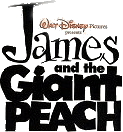

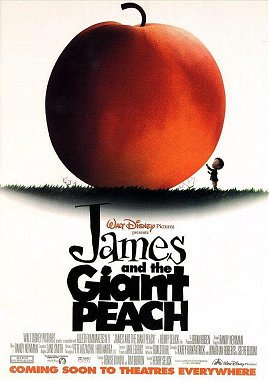 Directed
by: Henry Selick
Directed
by: Henry Selick
Written by: Roald Dahl & Karey Kirkpatrick
Music by: Randy Newman
Released on: April 12, 1996
Running Time: 79 minutes
Budget: $38 million
Box-Office: $29 million in the U.S., $
million worldwide
 |
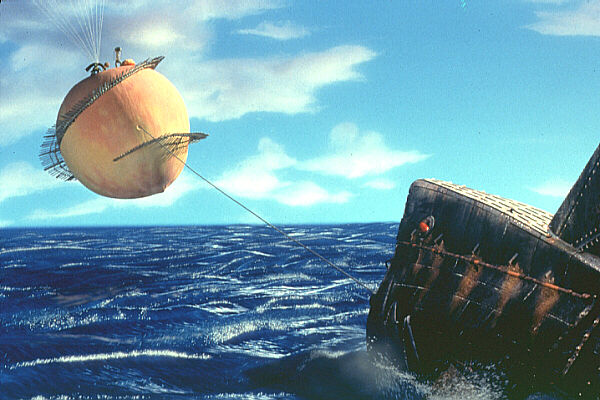 |
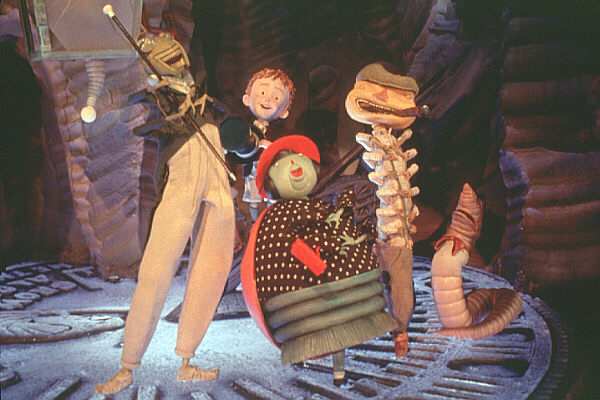 |
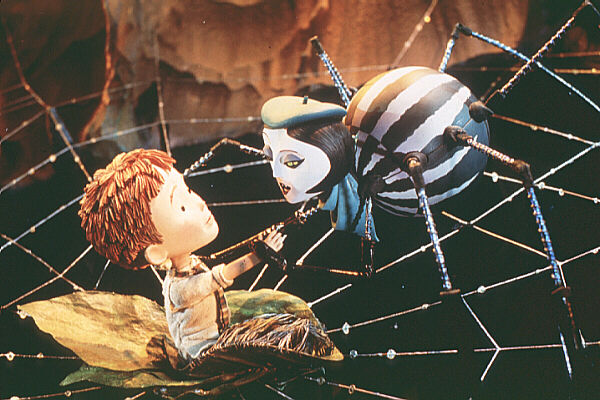 |
 |
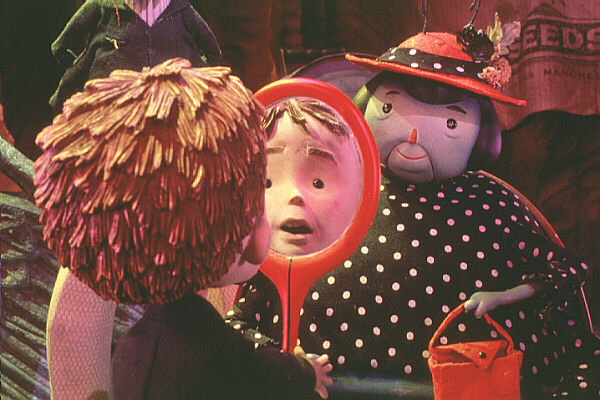 |
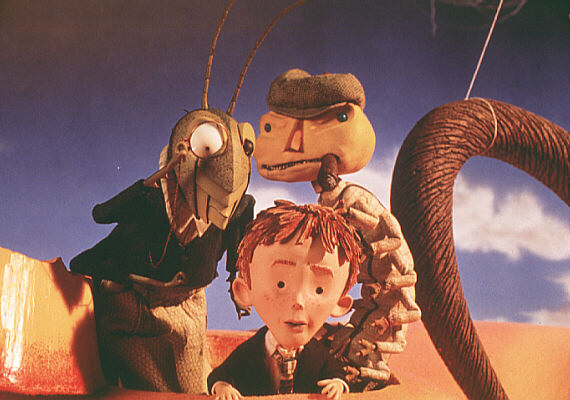 |
James... Paul Terry
Spider... Susan Sarandon (Like
Cats and Dogs)
Centipede... Richard Dreyfuss (Encounters of the Third Kind)
Aunt Spiker... Joanna Lumley (The New Avengers)
Earthworm... David Thewlis (Naked)
Grasshopper... Simon Callow
Ladybug... Jane Leeves
The Glowworm & Aunt Sponge... Miriam Margolyes (the matchmaker
in Mulan)
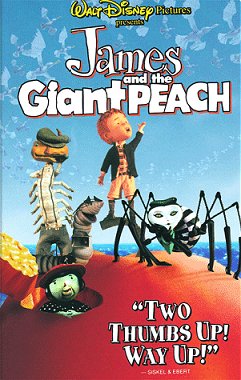
![]() Randy Newman's score was nominated for an Oscar in 1997.
Randy Newman's score was nominated for an Oscar in 1997.
![]() After the credits, there is some footage of a carnival game based
on the story being played.
After the credits, there is some footage of a carnival game based
on the story being played.
![]() When James and his friends are battling the skeleton pirates, one
of the skeleton pirates is an evil Donald Duck, and another one is none
other than Jack Skellington from The
Nightmare Before Christmas!
When James and his friends are battling the skeleton pirates, one
of the skeleton pirates is an evil Donald Duck, and another one is none
other than Jack Skellington from The
Nightmare Before Christmas!
![]() Henri Selick admitted in February 2001 that bookending James
and the Giant Peach with live action scenes "wasn't the ideal way to
go. It was a compromise. My original intention had been to keep him live
throughout, have him be a live actor, and then that budget was too high.
They didn't want to do that film as a high budget film. Then doing it all
as stop-motion was also high. Stop motion was more expensive to do than
the live-action bookends. It was a compromise idea. I think it was hard
on a lot of audiences. I believe it would have worked better either way,
all stop motion or as James all live throughout."
Henri Selick admitted in February 2001 that bookending James
and the Giant Peach with live action scenes "wasn't the ideal way to
go. It was a compromise. My original intention had been to keep him live
throughout, have him be a live actor, and then that budget was too high.
They didn't want to do that film as a high budget film. Then doing it all
as stop-motion was also high. Stop motion was more expensive to do than
the live-action bookends. It was a compromise idea. I think it was hard
on a lot of audiences. I believe it would have worked better either way,
all stop motion or as James all live throughout."
James and the Giant Peach began as a story that Roald Dahl, a master mystery writer, used to tell his children. In 1961, he finally put it in writing, and it was so successful that Dahl followed it up in 1964 with Charlie and the Chocolate Factory, which made it to the silver screen as Willy Wonka and the Chocolate Factory. Dahl's tale centers around James, a boy who is stuck living with his horrible aunts after his parents die. A strange old man gives him a bag of magical "green things" that he promptly drops on the ground, causing an old peach tree to sprout a rapidly expanding peach. James finds a tunnel into the peach and makes friends with a group of human-sized bugs: a spider, a ladybug, a centipede, a grasshopper, an earthworm, and a glowworm. The peach breaks free from the tree, and their wacky adventures begin.
Since the initial publication of James and the Giant Peach in 1961, this best-loved and best-selling tale has captured the fancy of several generations of readers and continues to be one of the most popular books of its genre. John Dahl himself believed that the book would be difficult if not impossible to translate into a film and repeatedly turned down offers from several prominent filmmakers who sought the rights. The author passed away in 1991, but when his widow, Liccy (Felicity), was approached by director Henry Selick about turning "James" into a film, she was so impressed with the magical stop-motion world he and his team had created for The Nightmare Before Christmas that she agreed to let him make the film.
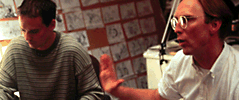
The story had to be adapted and a few liberties were taken by the movie:
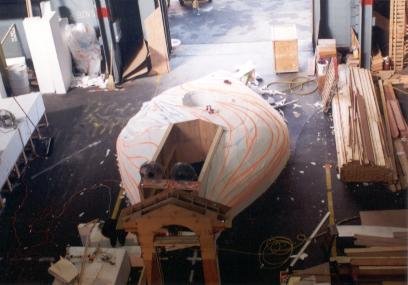 Much
of James was filmed at Skellington Studios, a warehouse in the South
of Market area of San Francisco, where director Henry Selick and executive
producer Tim Burton filmed the 1993 stop-motion feature The
Nightmare Before Christmas. Nightmare was one of the most
ambitious stop-motion projects to date, and Selick went even further with
James.
The crew was bigger (about 150 people), and Disney's backing made it possible
to lavish attention on each effect. The entire budget for Nightmare
was less than $18 million, while Disney spent more than $12.5 million just
on advertising for James -McDonald's spent another $35 million promoting
its Happy Meal with James and friends on 720 million food boxes.
Much
of James was filmed at Skellington Studios, a warehouse in the South
of Market area of San Francisco, where director Henry Selick and executive
producer Tim Burton filmed the 1993 stop-motion feature The
Nightmare Before Christmas. Nightmare was one of the most
ambitious stop-motion projects to date, and Selick went even further with
James.
The crew was bigger (about 150 people), and Disney's backing made it possible
to lavish attention on each effect. The entire budget for Nightmare
was less than $18 million, while Disney spent more than $12.5 million just
on advertising for James -McDonald's spent another $35 million promoting
its Happy Meal with James and friends on 720 million food boxes.
Creating James was a massive job: Selick began preproduction in early 1994, and the animation alone -which involved 180 puppets on 26 sets - took slightly more than a year. Out of 560 separate shots, 370 included special visual effects. Some of the more difficult -and impressive- scenes include an arctic ice floe and an underwater ship graveyard. This last setup (which was not in Roald Dahl's original book) allowed Selick to include a cameo by the Nightmare character Jack Skellington.
Because Disney wanted to mix the animation with live action, large sound
stages were set up at Hunter's Point (just south of San Francisco) and
on Treasure Island (halfway across the Bay Bridge), where the 1939 World's
Fair was held. Miriam Margoyles (Age of Innocence) and Joanna Lumley
(Patsy from Absolutely Fabulous) were brought in to play James's
evil aunts. The live scenes proved frustrating for Selick, who couldn't
fool with the results as he could in animated sequences.
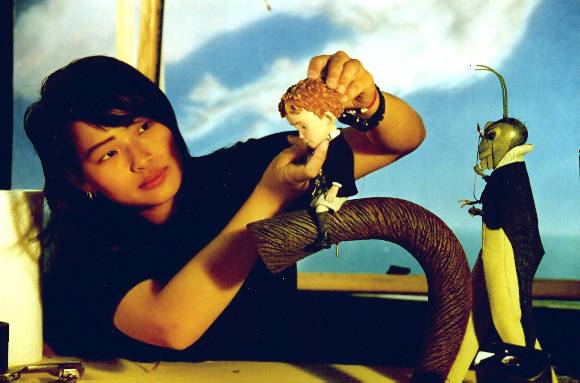 Stop-motion
animation dates back to Georges Méliès's Voyage to the
Moon (1902), and the technique was made famous in 1933 by King Kong.
The excruciatingly exacting process usually involves shooting one frame
of a puppet or figurine, then moving the puppet slightly to shoot another
frame, moving it again, and so on. It can take a week to shoot one minute
of stop-action film. At one point in the production of James, a
single scene was being shot simultaneously on seven identical sets, each
with different animators and camera crews. In order to avoid jerky
movements, director of photography Pete Kozachik put his cameras on tracks
and operated them by remote control with computers.
Stop-motion
animation dates back to Georges Méliès's Voyage to the
Moon (1902), and the technique was made famous in 1933 by King Kong.
The excruciatingly exacting process usually involves shooting one frame
of a puppet or figurine, then moving the puppet slightly to shoot another
frame, moving it again, and so on. It can take a week to shoot one minute
of stop-action film. At one point in the production of James, a
single scene was being shot simultaneously on seven identical sets, each
with different animators and camera crews. In order to avoid jerky
movements, director of photography Pete Kozachik put his cameras on tracks
and operated them by remote control with computers.
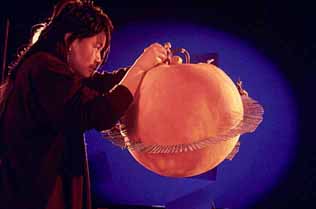 As
soon as she finished putting words in the mouths of the talking animals
in Babe, visual effects producer Nancy St. John hopped right into
James in early 1995. That year, she faced an organizational task a million
times bigger than any peach you can imagine: "We had to do a juggling act,"
St. John recalls. "What we create are called digital composites, basically
multilayered shots with different parts coming from different places. For
instance, we sent out some scenes to Sony Pictures Imageworks [an effects
house in LA] to get the water look, which is impossible in stop-action.
Then we hired Pacific Title for some last-minute optical work."
As
soon as she finished putting words in the mouths of the talking animals
in Babe, visual effects producer Nancy St. John hopped right into
James in early 1995. That year, she faced an organizational task a million
times bigger than any peach you can imagine: "We had to do a juggling act,"
St. John recalls. "What we create are called digital composites, basically
multilayered shots with different parts coming from different places. For
instance, we sent out some scenes to Sony Pictures Imageworks [an effects
house in LA] to get the water look, which is impossible in stop-action.
Then we hired Pacific Title for some last-minute optical work."
One particularly complex scene involves cloud effects from Jex Effects, lightning and water animated by computer, and stop-action characters moving in the foreground with blue screens.
"Continuity is the key," says St. John. "You have so many people touching each shot, from animators to camera people, with various sets and backgrounds -everything must look identical or you have to reshoot."
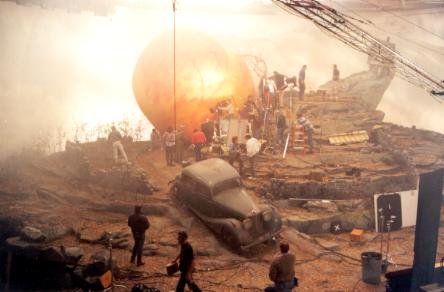 The
project became particularly difficult when live-action scenes were mixed
with animation. Production designer (and ILM alum) Harley Jessup had to
create layered sets (of 1940s New York and the aunts' house) to smooth
the transition between real and animated characters. To top it off, Selick
decided to model a 20-foot giant peach in one scene, rather than use a
computer effect. "The peach was a problem," says Jessup. "It was
made of a steel frame and foam, but weighed 2,500 pounds and was supposed
to roll down a hill. We had to barge it over to Treasure Island and bring
in a structural engineer to help us out."
The
project became particularly difficult when live-action scenes were mixed
with animation. Production designer (and ILM alum) Harley Jessup had to
create layered sets (of 1940s New York and the aunts' house) to smooth
the transition between real and animated characters. To top it off, Selick
decided to model a 20-foot giant peach in one scene, rather than use a
computer effect. "The peach was a problem," says Jessup. "It was
made of a steel frame and foam, but weighed 2,500 pounds and was supposed
to roll down a hill. We had to barge it over to Treasure Island and bring
in a structural engineer to help us out."
Stop-action animation requires incredible preparation. To make each puppet, a metal skeleton must be built that allows for easy movement. Then body parts made of painted latex are fitted over the armature. Main characters often require a variety of extra body parts for different situations. (For instance, there were 45 versions of James's head.) Some features - like lips - are removable, so that facial expressions can be changed. The animators who position the puppets need an incredible tolerance for tedium. They spend months with a given character, moving it in tiny increments.
"After a while," says Nancy St. John, "you can tell that a certain animator did a certain shot. The animator's personality shows through in the puppet, making it more boisterous or more laid back."
Brussels-born animator Guionne Leroy loved the switch to stop-action after working on computer animation for Pixar's Toy Story. "They were two different worlds," she says. "Pixar was a bright, well-lit office, very clean. Here, it was dark, dusty, sweaty, and we touched what we were animating. I preferred it here much more."
 Sean
Mathiesen, an editorial track reader, also got caught up in the details.
He made sure that every face and mouth movement matched with each spoken
sound. Spending countless hours at an Avid workstation, he studied and
corrected the same lip formations again and again.
Sean
Mathiesen, an editorial track reader, also got caught up in the details.
He made sure that every face and mouth movement matched with each spoken
sound. Spending countless hours at an Avid workstation, he studied and
corrected the same lip formations again and again.
"It's a real anal environment," he says. "You have to make sure the
mouth looks like it's saying 'kiss you' instead of 'kill you.' It's real
odd to concentrate on such minutiae. It's like an alternate reality."
Working with Disney was both a treat and a hassle for a crew that was used to a more independent style of filmmaking. Disney executives, for instance, wanted screenings every three months or so. The early screenings, according to some, were life-or-death affairs, with the possibility that the studio might drop out of the picture. Later, even though the execs were becoming more satisfied, the screenings still demanded weeks of preparation. Crew members would rush frantically to make the picture look good in time, then they'd have to take it apart to make requested fixes.
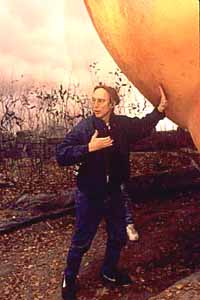 "Henry
Selick had a lot of headaches dealing with Disney," says one crew member.
"It was like a bad marriage. There was a lot of give and take, but at the
end, he probably wanted a divorce."
"Henry
Selick had a lot of headaches dealing with Disney," says one crew member.
"It was like a bad marriage. There was a lot of give and take, but at the
end, he probably wanted a divorce."
Not everyone felt the same tension level, though. According to Harley Jessup, the studio was smart enough to acknowledge that this film wasn't going to be trite or cute, and that Dahl's work had more of an edge than, say, Snow White. He also feels that the studio's experience with animation improved the final product.
As for Selick -well, he was not likely to beef, considering that he
had already signed a deal to produce three more stop-action films for the
Disney subsidiary Miramax!
|
||||||||||||